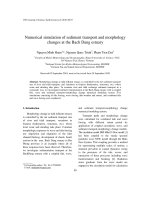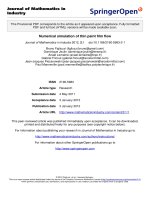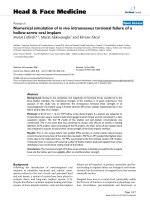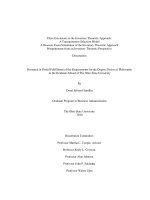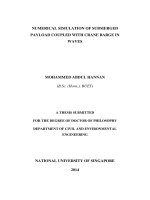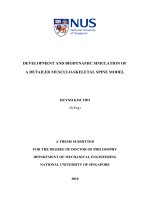Model development for numerical simulation of the behaviors of ph stimulus responsive hydrogels
Bạn đang xem bản rút gọn của tài liệu. Xem và tải ngay bản đầy đủ của tài liệu tại đây (6.06 MB, 267 trang )
MODEL DEVELOPMENT FOR NUMERICAL
SIMULATION OF THE BEHAVIORS OF pH-STIMULUS
RESPONSIVE HYDROGELS
YEW YONG KIN
(B.Eng. (Hons.), Universiti Teknologi Malaysia)
A THESIS SUBMITTED
FOR THE DEGREE OF DOCTOR OF PHILOSOPHY
DEPARTMENT OF MECHANICAL ENGINEERING
NATIONAL UNIVERSITY OF SINGAPORE
2006
i
SUMMARY
The modulation of the swelling ability of the hydrogel in responses to pH and
electric stimuli enables us to dynamically control the conversion of electrochemical
energy into mechanical energy, thereby obtaining effective diffusivity and
permeability of the solutes or performing mechanical work.
In this thesis, a chemo-electro-mechanical model is developed to simulate the
deformation characteristics of the pH-stimuli responsive hydrogel based on multi-field
effects formulation, and it is termed the Multi-Effect-Coupling of pH-Stimulus
(MECpH) model. This model accounts for the ionic fluxes within both the hydrogel
and surrounding solution, the coupling between the ionic diffusion, electric potential,
and mechanical deformation in the hydrogel. The model also incorporates the
relationship between the concentrations of the ionizable fixed charge groups and the
diffusive hydrogen ion, which follows a Langmuir isotherm theory, into the Poisson-
Nernst-Planck system. On top of that, the finite deformation has been considered in the
formulation of mechanical equilibrium equation.
In order to validate the MECpH model, one-dimensional steady-state
simulations of the hydrogel deformation with salt concentration, pH and electric
potential as the main stimuli are carried out via a meshless Hermite Cloud method and
Newton-Raphson iterative procedure. The numerical results are compared with
available experimental data. The simulations show a satisfactory agreement with the
experiment data from open literature qualitatively and quantitatively. The steady-state
ii
behaviors of swelling equilibrium of hydrogel are demonstrated here in the context of
nonlinear chemoelectromechanical theories.
In addition, the behaviors of the hydrogel are considerably dependent on it
bathing environment, as well as the physical and chemical nature of the hydrogel. The
significances of those factors on the equilibrium deformation can be inferred by
tracking the changes of the average curvature or dimension of the hydrogel. The
illustrated results are analyzed and discussed with the support of the experimental data
from other research groups. Those simulation results are confirmed to be quantitatively
consistent with the real measured data. Present studies prove that the MECpH model is
accurate, efficient and numerically stable for providing a possible simulating tool for
analysis of the nonlinear behavior of the pH-sensitive hydrogel.
iii
ACKNOWLEDGEMENTS
I owe a great debt of gratitude to my supervisor, Prof Lam Khin Yong, who provided
me with continuous encouragement and support. It has been a great learning
experience for me to work with him. Assoc Prof Ng Teng Yong and Dr Li Hua were
instrumental in helping me start my work in Institute of High Performance Computing
(IHPC). They have continually lent support through the many years, as well as giving
meticulous criticism of my works.
This work was largely written and created at IHPC, where I have spent a large part of
my research. The work would not be in successful completion if not the help and
encouragement from my friends and staffs in IHPC. I am indebted to many of them;
many fruitful discussions have contributed to form most part of the dissertation.
I am fortunate in that I had expert guidance all this while in the field, and I would like
to take this opportunity to thank those who have set me on the right road.
Dissertation is not written without a lot of family support. They have given me their
unflagging support during those difficult years. My debt to them can never be repaid.
Finally, I would also like to thank the National University of Singapore and the
Institute of High Performance Computing for giving financial support.
iv
TABLE OF CONTENTS
Summary……………………………………………………………………………………i
Acknowledgement……………………………………………………………………… iii
Table of Contents………………………………………………………………………….iv
List of Figures………………………………………… ……………………………… viii
List of Tables………………………………………………………………………… xv
List of Symbols………………………………………………………………………… xvi
Chapter 1 Introduction
1.1 Background……………………………………………………………………… 1
1.1.1 Hydrogels and Their Applications…………………………………………1
1.1.2 pH-Sensitive Hydrogels…………………………………………………….4
1.2 Objectives and Scope………………………………………………………………5
1.3 Literature Survey………………………………………………………………… 7
1.3.1 Theoretical Model………………………………………………………….7
1.3.2 Chemically Driven Hydrogels…………………………………………….12
1.3.3 Electrically Driven Hydrogels……………………………………………14
1.4 Layout of Dissertation…………………………………………………………….17
v
Chapter 2 Development of Mathematical Model for Swelling of pH-Sensitive
Hydrogel
2.1 Overview………………………………………………………………………….21
2.2 Review of Existing Theoretical Models………………………………………… 22
2.2.1 Thermodynamics Model………………………………………………… 22
2.2.2 Mixture Theory – Multiphasic Mechano-Electrochemical Model……… 31
2.3 Development of Multi-Effect-Coupling pH-Stimulus (MECpH) Model for pH-
Sensitive Hydrogels
2.3.1 Overview………………………………………………………………… 36
2.3.2 Electrochemical Formulation…………………………………………….38
2.3.2.1 Ionic Flux Equation……………………………………………….40
2.3.2.2 Spatial Charge…………………………………………………….43
2.3.2.3 Fixed Charge Groups Interaction……………………………… 49
2.3.3 Mechanical Formulation………………………………………………….51
2.3.4 Computational Domain and Boundary Conditions……………………….57
2.3.5 Equivalent Non-dimensional MECpH Model for One-Dimensional Steady-
State Problems…………………………………………………………….58
2.4 Remarks………………………………………………………………………… 63
Chapter 3 Development of Novel Meshless Methodology
3.1 Overview………………………………………………………………………….66
3.2 Hermite Cloud Method……………………………………………………………70
3.3 Discretization of Partial Differential Boundary Value Problem………………….80
3.4 Numerical Validations ………………………………………………………… 82
vi
3.4.1 Patch Test for Elasticity………………………………………………… 85
3.4.2 Plane Stress Patch Subjected to Pure Bending………………………… 87
3.4.3 Cantilever Beam Loader under Pure Bending……………………………89
3.4.4 Patch Subjected to Thermal Stress……………………………………… 91
3.4.5 Heat Conduction with Localized High Gradient……………………… 94
3.5 Numerical Solution of One-Dimensional Steady-State MECpH model………….96
3.6 Remarks………………………………………………………………………….100
Chapter 4 Steady-State Simulations of Equilibrium Swelling of pH-Sensitive
Hydrogel in the Presence of pH Stimulus
4.1 Overview…………………………………………………………………… 110
4.2 Model Validations with Experimental Results………………………………… 112
4.3 Parametric Studies of Hydrogel Properties and Environmental Conditions…….114
4.3.1 Influences of the Ionizable Group Concentration of Hydrogel………….117
4.3.2 Influences of the Young’s Modulus of Hydrogel……………………… 120
4.3.3 Influences of the Initial Diameter of Hydrogel….………………………122
4.3.4 Influences of the Ionic Strength of Bath Solution……………………….123
4.3.5 Influences of the Ionic Compositions of Bath Solution………………….126
4.4 Discussions and Conclusions………………………………………………… 128
Chapter 5 Steady-State Simulations of Equilibrium Swelling of pH-Sensitive
Hydrogel in Concurrent Presence of pH and Electrical Stimuli
5.1 Overview………………………………………………………………… … 159
5.2 Model Validations with Experimental Results…………………………… … 161
vii
5.2.1 Responses of Hydrogel to Externally Applied Electric Field….……… 161
5.2.1.1 Comparison with Theorectical Calculation……………….……161
5.2.1.2 Comparison with Experimental Data………………….……… 162
5.2.2 Responses of Hydrogel to Simultaneous Effects of Chemically and
Electrically Induced Condition…………………………………….……163
5.2.2.1 Comparison with Experimental Data………………………… 163
5.2.2.2 Analysis of the Characteristics of Hydrogel at Steady-State… 165
5.3 Parametric Studies of Hydrogel Properties and Environmental Conditions…….170
5.3.1 Influences of the Ionizable Group Concentration of Hydrogel………….170
5.3.2 Influences of the Young’s Modulus of Hydrogel……………………… 173
5.3.3 Influences of the Initial Thickness of Hydrogel…………………………174
5.3.4 Influences of the Ionic Strength of Bath Solution……………………… 176
5.3.5 Influences of the Ionic Compositions of Bath Solution………………….178
5.4 Discussions and Conclusions……………………………………………………181
Chapter 6 Concluding remarks
6.1 Summary……………………………………………………………………… 221
6.2 Suggestions for future work…………………………………………………… 223
References 226
Publication arising from dissertation…………………………………………………248
viii
LIST OF FIGURES
Figure 1.1 Schematic representation of hydrogel structures ……………………… 20
Figure 1.2 Reversible expansion or contraction of ionic hydrogel when pH changes
[Lowman and Peppas, 1999] …………………………………………… 20
Figure 3.1 Patch test for elasticity………………………………………………… 103
Figure 3.2 Plane stress patch subjected to pure bending…………………………… 104
Figure 3.3 2D cantilever beam under pure bending……………………………… 105
Figure 3.4 Patch subjected to temperature field…………………………………… 106
Figure 3.5 Heat conduction with localized high gradient temperature field……… 108
Figure 3.6 Flow chart of relaxation approach for self-consistent MECpH model… 109
Figure 4.1 Computational domain and boundaries conditions for the numerical
simulations. The shaded areas are the pH-responsive hydrogel………….131
Figure 4.2 Comparison of finite and linear deformation theories……………….… 133
Figure 4.3 Comparison between experimental and numerical results predicted by
MECpH model for the equilibrium swelling of PHEMA based hydrogels as a
function of pH …………………………………………………….…… 133
Figure 4.4 Profiles of
+
H
c
,
+
Na
c
,
-
Cl
c
,
f
c
,
ψ
, and
u
as a function of ionizable fixed charge
concentration
s
mo
c . The PHEMA based hydrogel is equilibrated in an acidic
medium of pH3 with NaCl added to control the ionic strength………… 134
Figure 4.5 Profiles of
+
H
c
,
+
Na
c
,
-
Cl
c
,
f
c
,
ψ
, and
u
as a function of ionizable fixed charge
concentration
s
mo
c
. The PHEMA based hydrogel is equilibrated in a neutral
medium with NaCl added to control the ionic strength………… 135
ix
Figure 4.6 Profiles of
+
H
c
,
+
Na
c
,
-
Cl
c
,
f
c
,
ψ
, and
u
as a function of ionizable fixed charge
concentration
s
mo
c
. The PHEMA based hydrogel is equilibrated in a basic
medium of pH12 with NaCl added to control the ionic strength……… 136
Figure 4.7 Dependence of swelling degree on (a) bathing pH as a function of ionizable
fixed charge concentration
s
mo
c
, and (b) varying ionizable fixed charge
concentration
s
mo
c
in acidic, neutral and basic solution………………… 137
Figure 4.8 Influences of buffer systems on swelling equilibria as a function of ionizable
fixed charge concentration in (a) acidic medium of pH3, and (b) basic
medium of pH9……………………………………………………………138
Figure 4.9 Profiles of
+
H
c
,
+
Na
c
,
-
Cl
c
,
f
c
,
ψ
, and
u
as a function of normalized Young’s
modulus (
0
/
E
E
). The PHEMA based hydrogel is equilibrated in an acidic
medium of pH3 with NaCl added to control the ionic strength………… 139
Figure 4.10
Profiles of
+
H
c
,
+
Na
c
,
-
Cl
c
,
f
c
,
ψ
, and
u
as a function of normalized Young’s
modulus (
0
/
E
E
). The PHEMA based hydrogel is equilibrated in a neutral
medium with NaCl added to control the ionic strength………………… 140
Figure 4.11 Profiles of
+
H
c
,
+
Na
c
,
-
Cl
c
,
f
c
,
ψ
, and
u
as a function of normalized Young’s
modulus (
0
/
E
E
). The PHEMA based hydrogel is equilibrated in a basic
medium of pH12 with NaCl added to control the ionic strength………….141
Figure 4.12 Dependence of swelling degree on (a) bathing pH as a function of
normalized Young’s modulus (
0
/
E
E
), and (b) varying normalized Young’s
modulus (
0
/
E
E
) in acidic, neutral and basic solution……………………142
Figure 4.13 Influences of buffer systems on swelling equilibria as a function of
normalized Young’s modulus (
0
/
E
E
) in (a) acidic medium of pH3, and (b)
basic medium of pH9…………………………………………………… 143
Figure 4.14 Profiles of
+
H
c
,
+
Na
c
,
-
Cl
c
,
f
c
,
ψ
, and u as a function of initial diameter of
hydrogel (dry gel diameter). The PHEMA based hydrogel is equilibrated in
an acidic medium of pH3 with NaCl added to control the ionic strength…144
Figure 4.15 Profiles of
+
H
c
,
+
Na
c
,
-
Cl
c
,
f
c
,
ψ
, and
u
as a function of initial diameter of
hydrogel (dry gel diameter). The PHEMA based hydrogel is equilibrated in a
neutral medium with NaCl added to control the ionic strength………… 145
x
Figure 4.16 Profiles of
+
H
c
,
+
Na
c
,
-
Cl
c
,
f
c
,
ψ
, and
u
as a function of initial diameter of
hydrogel (dry gel diameter). The PHEMA based hydrogel is equilibrated in a
basic medium of pH12 with NaCl added to control the ionic strength… 146
Figure 4.17 Dependence of hydration parameter on (a) bathing pH as a function of initial
diameter of hydrogel (dry gel diameter), and (b) hydrogel diameter at dry
state in acidic, neutral and basic solution………………………………….147
Figure 4.18 Influences of buffer system on hydration parameter as a function of initial
diameter of hydrogel (dry gel diameter) in (a) acidic medium of pH3, and (b)
basic medium of pH9…………………………………………………… 148
Figure 4.19 Profiles of
+
H
c
,
+
Na
c
,
-
Cl
c
,
f
c
,
ψ
, and
u
as a function of swelling medium
ionic strength. The PHEMA based hydrogel is equilibrated in an acidic
medium of pH3 with NaCl added to control the ionic strength………… 149
Figure 4.20 Profiles of
+
H
c
,
+
Na
c
,
-
Cl
c
,
f
c
,
ψ
, and u as a function of swelling medium
ionic strength. The PHEMA based hydrogel is equilibrated in a neutral
medium with NaCl added to control the ionic strength………………… 150
Figure 4.21 Profiles of
+
H
c
,
+
Na
c
,
-
Cl
c
,
f
c
,
ψ
, and
u
as a function of swelling medium
ionic strength. The PHEMA based hydrogel is equilibrated in a basic
medium of pH12 with NaCl added to control the ionic strength………….151
Figure 4.22 Dependence of swelling degree on (a) bathing pH as a function of ionic
strength of swelling medium, and (b) varying ionic strength in acidic, neutral
and basic swelling medium……………………………………………… 152
Figure 4.23 Influences of buffer system on hydration parameter as a function of ionic
strength of swelling medium in (a) acidic medium of pH3, and (b) basic
medium of pH9……………………………………………………………153
Figure 4.24 Profiles of
+
H
c
,
+
M
c
,
-
N
c
,
f
c
,
ψ
, and
u
for particular solvent composition
(monovalents, divalents, trivalents). The PHEMA based hydrogel is
equilibrated in an acidic medium of pH3………………………………….154
Figure 4.25 Profiles of
+
H
c
,
+
M
c
,
-
N
c
,
f
c
,
ψ
, and u for particular solvent composition
(monovalents, divalents, trivalents). The PHEMA based hydrogel is
equilibrated in a neutral medium………………………………………… 155
Figure 4.26 Profiles of
+
H
c
,
+
M
c
,
-
N
c
,
f
c
,
ψ
, and
u
for particular solvent composition
(monovalents, divalents, trivalents). The PHEMA based hydrogel is
equilibrated in a basic medium of pH12………………………………… 156
xi
Figure 4.27 Dependence of swelling degree on (a) solvent composition (monovalents,
divalents, trivalents) as a function of bathing pH, and (b) ionic strength of
swelling medium in different ionic valencies of bathing solution……… 157
Figure 4.28 Effects of ionic valencies of bathing solution on swelling equilibria as a
function of ionic strength in (a) acidic medium of pH3, and (b) basic
medium of pH9……………………………………………………………158
Figure 5.1 (a) Schematic illustration of the polyacidic (anionic) hydrogel swollen in
aqueous solution under the influence of external DC electric current and (b)
boundaries conditions for the numerical solution…………………………183
Figure 5.2 Comparison of electrical potential in the gel and bathing solution due to
applied external electric field between (a) stabilized space-time FEM
(Wallmersperger, 2001a) and (b) Hermite Cloud meshless method (Li,
2003).…………………………………………………………………… 184
Figure 5.3 Comparison of the finite and linear deformation results of MECpH model
with experimental data and theoretical results of Zhou et al.(2001)………185
Figure 5.4 Comparison between simulation results and experimental data (Kim et al.,
2004) for swelling ratio of PMAA/PVA IPN hydrogel as variation of pH
environment……………………………………………………………… 186
Figure 5.5 Simulation versus experiment (Kim et al., 2004) for equilibrium bending
angle of PMAA/PVA IPN hydrogel as a function pH environment when
constant voltage of 15V is applied across the hydrogel strip…………… 186
Figure 5.6 Profiles of
+
H
c
,
+
Na
c
,
-
Cl
c
,
f
c
,
ψ
,
P
,
u
and
elastic
ε
as a function of applied
electric potential
e
V
. The PHEMA based hydrogel is equilibrated in an acidic
medium of pH3 with NaCl added to control the ionic strength………… 187
Figure 5.7 Profiles of
+
H
c
,
+
Na
c
,
-
Cl
c
,
f
c
,
ψ
,
P
, u and
elastic
ε
as a function of applied
electric potential
e
V
. The PHEMA based hydrogel is equilibrated in an
neutral medium with NaCl added to control the ionic strength………… 189
Figure 5.8 Profiles of
+
H
c
,
+
Na
c
,
-
Cl
c
,
f
c
,
ψ
,
P
,
u
and
elastic
ε
as a function of applied
electric potential
e
V
. The PHEMA based hydrogel is equilibrated in a basic
medium of pH12 with NaCl added to control the ionic strength………….191
Figure 5.9 Profiles of
+
H
c
,
+
Na
c
,
-
Cl
c
,
f
c
,
ψ
,
P
, u and
elastic
ε
as a variation of pH swelling
medium. The PHEMA based hydrogel is equilibrated in NaCl electrolyte
solution under the influence of applied voltage of 1.0V………………… 193
xii
Figure 5.10 Effects of pH environment with varying applied voltage on (a) swelling
equilibrium of hydrogel, (b) average bending curvature of hydrogel…… 195
Figure 5.11 Effects of externally applied voltage on (a) swelling equilibrium of hydrogel,
(b) average bending curvature of hydrogel; in acidic, neutral and basic
solution…………………………………………………………………….196
Figure 5.12 Effects of pH environment with varying ionizable fixed charge concentration
on (a) swelling equilibrium of hydrogel, (b) average bending curvature of
hydrogel; under the influence of applied voltage of 0.5V……………… 197
Figure 5.13 Effects of externally applied voltage with varying ionizable fixed charge
concentration on (a) swelling equilibrium of hydrogel, (b) average bending
curvature of hydrogel; in acidic swelling medium of pH3……………… 198
Figure 5.14 Effects of externally applied voltage with varying ionizable fixed charge
concentration on (a) swelling equilibrium of hydrogel, (b) average bending
curvature of hydrogel; in basic swelling medium of pH12……………… 199
Figure 5.15 Effects of ionizable fixed charge concentration with varying applied voltage
on (a) swelling equilibrium of hydrogel, (b) average bending curvature of
hydrogel; in acidic swelling medium of pH3…………………………… 200
Figure 5.16 Effects of ionizable fixed charge concentration with varying applied voltage
on (a) swelling equilibrium of hydrogel, (b) average bending curvature of
hydrogel; in basic swelling medium of pH12…………………………… 201
Figure 5.17 Effects of pH environment with varying normalized Young’s modulus on (a)
swelling equilibrium of hydrogel, (b) average bending curvature of hydrogel;
under the influence of applied voltage of 0.5V……………………………202
Figure 5.18 Effects of externally applied voltage with varying normalized Young’s
modulus on (a) swelling equilibrium of hydrogel, (b) average bending
curvature of hydrogel; in acidic swelling medium of pH3……………… 203
Figure 5.19 Effects of externally applied voltage with varying normalized Young’s
modulus on (a) swelling equilibrium of hydrogel, (b) average bending
curvature of hydrogel; in basic swelling medium of pH12……………… 204
Figure 5.20 Effects of normalized Young’s modulus with varying applied voltage on (a)
swelling equilibrium of hydrogel, (b) average bending curvature of hydrogel;
in acidic swelling medium of pH3……………………………………… 205
Figure 5.21 Effects of normalized Young’s modulus with varying applied voltage on (a)
swelling equilibrium of hydrogel, (b) average bending curvature of hydrogel;
in basic swelling medium of pH12……………………………………… 206
xiii
Figure 5.22 Effects of pH environment with varying dry-state gel thickness on (a)
swelling equilibrium of hydrogel, (b) average bending curvature of hydrogel;
under the influence of applied voltage of 0.5V……………………………207
Figure 5.23 Effects of externally applied voltage with varying dry-state gel thickness on
(a) swelling equilibrium of hydrogel, (b) average bending curvature of
hydrogel; in acidic swelling medium of pH3…………………………… 208
Figure 5.24 Effects of externally applied voltage with varying dry-state gel thickness on
(a) swelling equilibrium of hydrogel, (b) average bending curvature of
hydrogel; in basic swelling medium of pH12…………………………… 209
Figure 5.25 Effects of dry-state gel thickness with varying applied voltage on (a)
swelling equilibrium of hydrogel, (b) average bending curvature of hydrogel;
in acidic swelling medium of pH3……………………………………… 210
Figure 5.26 Effects of dry-state gel thickness with varying applied voltage on (a)
swelling equilibrium of hydrogel, (b) average bending curvature of hydrogel;
in basic swelling medium of pH12……………………………………… 211
Figure 5.27 Effects of pH environment with varying solution ionic strength on (a)
swelling equilibrium of hydrogel, (b) average bending curvature of hydrogel;
under the influence of externally applied voltage of 0.5V……………… 212
Figure 5.28 Effects of externally applied voltage with varying solution ionic strength on
(a) swelling equilibrium of hydrogel, (b) average bending curvature of
hydrogel; in acidic swelling medium of pH3…………………………… 213
Figure 5.29 Effects of externally applied voltage with varying solution ionic strength on
(a) swelling equilibrium of hydrogel, (b) average bending curvature of
hydrogel; in basic swelling medium of pH12…………………………… 214
Figure 5.30 Effects of solution ionic strength with varying applied voltage on (a)
swelling equilibrium of hydrogel, (b) average bending curvature of hydrogel;
in acidic swelling medium of pH3……………………………………… 215
Figure 5.31 Effects of solution ionic strength with varying applied voltage on (a)
swelling equilibrium of hydrogel, (b) average bending curvature of hydrogel;
in basic swelling medium of pH12……………………………………… 216
Figure 5.32 Effects of externally applied voltage with varying solution composition on (a)
swelling equilibrium of hydrogel, (b) average bending curvature of hydrogel;
in acidic swelling medium of pH3……………………………………… 217
Figure 5.33 Effects of externally applied voltage with varying solution composition on (a)
swelling equilibrium of hydrogel, (b) average bending curvature of hydrogel;
in basic swelling medium of pH12……………………………………… 218
xiv
Figure 5.34 Effects of solution composition with varying applied voltage on (a) swelling
equilibrium of hydrogel, (b) average bending curvature of hydrogel; in acidic
swelling medium of pH3………………………………………………… 219
Figure 5.35 Effects of solution composition with varying applied voltage on (a) swelling
equilibrium of hydrogel, (b) average bending curvature of hydrogel; in basic
swelling medium of pH12…………………………………………………220
xv
LIST OF TABLES
Table 4.1 Essential chemical and physical parameters used as input data for
implementation of the numerical simulations………………………………132
xvi
LIST OF SYMBOLS
k
c
interior ionic concentration of species k
k
c
ionic concentration of species k in exterior solution
0
s
m
c
total ionizable groups per unit solid volume
f
c
fixed charge concentration
k
D
diffusion coefficient of the k
th
species
0
D
diffusion coefficient in the pure solvent
D
material moduli tensor
el
D
electric displacement tensor
0
E
Young’s modulus
Ε strain tensor of solid matrix
el
E
electric field tensor
F
deformation gradient tensor
F Faraday’s constant of 96485 C/mol
ij
f
frictional drag coefficients between the inter-diffusing i and j components
GΔ
Gibbs free energy
g osmotic coefficient
I identity tensor
el
I
electrical current density
J determinant of deformation gradient
a
K
dissociation constant
B
k
Boltzmann’s constant of
23 -1
1.3807 10 JK
−
×
i
M
molecular weight of i
th
component
k
N
flux of the k
th
ionic species
N
mole fraction
n number of mole
p pressure
P
first Piola-Kirchhoff stress tensor
el
P
electric polarization tensor
R universal gas constant of
KJ/mol 8.314
⋅
k
r
radius of the diffusing molecule
S
second Piola-Kirchhoff stress tensor
xvii
T absolute temperature, in K
c
T
chemical expansion stress due to the presence of the charge-to-charge electrostatic
repulsive forces
i
U fluid velocity relative to the solid in i direction
i
V
volume of i
th
component
v
partial molar volume
k
z valence numbers of ionic species k
f
z
valence numbers of fixed charge group
i
v velocity of the i
th
component
σ
Cauchy stress of the mixture
k
γ
chemical activity coefficient of k
th
species
ψ
electrostatic potential
υ
Poisson’s ratio
i
φ
volume fraction of i
th
component
χ
Flory interaction parameter
ϑ
number of chains
i
α
ratio of the deformed length to the undeformed length in i direction, (i=x,y,z)
i
μ
chemical potential of i
th
component
0
i
μ
chemical potential of i
th
component at the reference configuration
el
k
μ
mobility of of ionic species k
i
ρ
mass density of i
th
component
el
ρ
charge density
λ
,
μ
Lamé constants
D
λ
Donnan partitioning ratio
ε
relative dielectric constant
0
ε
dielectric constant of
2212
/NmC 108.85418
−
×
1
CHAPTER 1
INTRODUCTION
1.1 BACKGROUND
1.1.1 Hydrogels and Their Applications
Hydrogels are form of matters that possess both the properties of solid and
liquid (Tanaka, 1981; Osada and Gong, 1993). Their structural frameworks are formed
from networks of randomly cross-linked macromolecules that embody three different
phases, namely, solid matrix network, interstitial fluid and ion. A schematic drawing of
the hydrogel structure is shown in Figure 1.1. The solid portion of the hydrogel is a
network of cross-linked polymer chains where their three-dimensional structure is
usually described as a mesh, with the interstitial space filled up with fluid. Those
meshes of networks hold the fluid in place and also impart rubber-like elastic force that
will counter the expansion/contraction of the hydrogel, thus providing the solidity to
the hydrogel (Osada and Ross-Murphy, 1993). The cross-linked network can be
formed physicochemically, for instance, by hydrogen bonding, van der Waals
interactions between chains, covalent bond, crystalline, electrostatic interactions or
physical entanglements (Lowman and Peppas, 1999). On the other hand, the fluid
phase that filled up the interstitial pores of the network gives the hydrogel its wet and
soft properties, which resemble, in some respects, to biological tissues (Mow et al.,
2
1999). The ionic phase is generally composed of a number of mobile ions (counter ions
and co-ions due to the presence of electrolytic solvent that surround the hydrogel) and
ionizable groups bound to the polymer chains. The ionizable groups will dissociate in
solution completely for strong electrolyte or partially for weak polyelectrolyte groups
and the network is left with the charged groups fixed to its chains. These fixed charge
groups produce electrostatic repulsion force among themselves, which will add
influence to the expansion of gel network. It is therefore known that fixed charge
density, an important factor in the electrostatic force, will play a substantial role in
changing the swelling of a gel.
Various materials, both naturally existing and synthetic, are examples of water
swollen polymeric hydrogels. Crosslinked guar gum and collagens are examples of
natural polymer that are modified to produce hydrogels. Classes of synthetic hydrogels
include PAA ― poly(acrylic acid), PHEMA ― poly(hydroxyethyl methacrylate),
PAM ― poly(acrylamide), PVA-PAA ― poly(vinyl alcohol) poly(acrylic acid),
PAN ― poly(acrylonitrile), PAN/PPY poly(acrylonitrile) poly(pyrrole), NIPA ― N-
isopropylacrylamide, etc. Depending on the physical and chemical characteristics of
the polymer, hydrogel can be categorized further into subclasses. For example,
hydrogels can be synthesized to be either neutral or ionic, determined by the chemical
characteristic of the pendant groups fixed to the matrix. From the point of physical
mechanism, if the overall structure of hydrogels is homogeneous, the polymer chains
have a high degree of mobility. If it is heterogeneous, there is a great deal of inter-
polymer interaction and the polymer chains are virtually immobile at the molecular
level (Muhr and Blanshard, 1982). However, the eventual stability of the hydrogel
depends on the interaction between its network and the aqueous medium where it is
immersed.
3
Motivated by the pioneering works of Tanaka and his colleagues (Tanaka, 1978,
1981), an entire new class of hydrogels was introduced. Those hydrogels demonstrate
the unique property of undergoing discrete or continuous volume transformation in
response to infinitesimal changes of external environment conditions, such as pH
(Gehrke and Cussler, 1989; Seigel, 1990; Brannon-Peppas et. al., 1991a; Chu et. al.,
1995), temperature (Tanaka, 1978, 1979; Marchetti et al., 1990), electric field (Tanaka
et. al., 1982), solvent composition (Tanaka et. al., 1980), salt concentration (Ohmine et.
al., 1982), light/photon (Irie, 1986; Irie and Kunwatchakun, 1986; Suzuki and Tanaka,
1990), coupled magnetic and electric fields (Suleimenov et al., 2001 ) and so on. These
magnificent features make the hydrogel better known as stimuli-responsive or smart
hydrogels.
Due to their unique properties that include swelling behavior, sorption
capacities, mechanical properties, permeabilities and surface properties, hydrogels
provide the instrumentation for creating functional materials for broad spectrum of
applications as they can sense the environmental changes and eventually induce
structural changes without a need for an external power source. Artificial muscle
(Shahinpoor, 1995; Bar-Cohen, 2001), microfludic control (Beebe, et al., 2000),
sensors/actuators (Brock, et. al., 1994), separation process (Andrews, 1986; Galaev
and Mattiasson, 2002; Kobayashi, 2003), and chromatographic packing (Tanaka and
Araki, 1989) are just few examples of the successful applications of hydrogels.
Another exceptional promise of the hydrogels is their biocompatibility and biostability
potentials (Park and Park, 1996), suggesting that the hydrogel are also an excellent
substitution for the human body tissues or biomimetic applications. There are also
extensive exploration of the hydrogels in the medical and pharmaceutical application,
such as drug delivery system (DeRossi et. al. 1991; Kwon et al., 1991a; Khare and
4
Peppas, 1995; Brazel and Peppas, 1999), articular cartilage (Lai et. al., 1991; Noguchi
et al., 1991), biomaterial scaffold (Lee et al., 2003), corneal replacement (Hicks et. al.,
1997) and tissue engineering (Elbert and Hubbel, 1996; Suh and Matthew, 2000).
Peppas (1987), De Rossi et al. (1991), Osada and Gong (1993), Shahinpoor et al.
(1998), Peppas et al. (2000a, 2000b) and Dumitriu (2002) have given some notable
reviews of these highly maneuverable smart and adaptive structures in their respected
fields.
1.1.2 pH-Sensitive Hydrogel
As pH is the most widely utilized triggering signals for modulating
physicochemical stimulus-responsive hydrogels, the studies on the behavior of pH-
sensitive hydrogel will be the focus of present thesis.
The pH-sensitive hydrogels contain acidic or basic groups bound to the
polymer backbone. These pendent groups will be ionized or protonated in response to
the external pH changes. Carboxyl, sulfonic, and amino groups are the popular
ionizable groups used to prepare pH-sensitive hydrogel. For acidic hydrogels, the
pendent groups are unionized below the dissociation constant pK
a
. When bathed in pH
above the pK
a
, the pendent groups start to ionize. As a result, the hydrogels expand
enormously as the osmotic pressure is created due to the concentration gradient of ions.
Hence, the acidic or basic strength of the pendent groups is an important foctor
controlling the magnitude of expansion (Grignon and Scallan, 1980; Cussler et al.,
1984). In principle, weak-acid groups such as carboxyl groups exist in the form
of ―COOH in low pH and deprotonated become ―COO
–
in high pH solution. In
contrast, strong acid groups such as ―SO
3
–
remain ionized even at low pH. In basic
5
hydrogels, the pendent groups are unionized above the dissociation constant pK
b
of the
basic groups. Whereas, the pendent groups are ionized as the environmental pH
decrease from the pK
b
value, enhancing the swelling degree of the hydrogel (Hirokawa
et al., 1985; Katayama and Ohata, 1985; Podual et al., 2000). Likewise, weak-base
groups such as ―NH
3
+
is deprotonated, forming uncharged ―NH
2
when the pH is
high, and strong-base groups such as ―N
+
(CH
3
)
3
remain ionized even at high pH.
In conclusion, the swelling of the pH-sensitive hydrogel is generally governed
by chemical nature of fixed charge groups bound to the network and the swelling agent,
which is completely reversible in nature, as depicted in Fig 1.2.
1.2 OBJECTIVES AND SCOPE
Computer simulation is becoming an alternative branch of research
complementary to experiments and analytical theory. It offers great deal of advantages,
for instance, the freedom to control the parameters of the system and properties of the
material, direct access to the microscopic structures and dynamics, and in particular,
providing the bridging between the analytical theory and experiment.
All this while, most of the research explorations of these fascinating new
materials is based on experimental trial-and-error, which are very time consuming.
These have hindered the development of new materials, and delayed the transfer of
new applications from the laboratory to the marketplace. The need to bring innovative
and high-quality products to market in the shortest time is driving the use of models
that can speed up the design and realization process.
6
On top of that, the experimentalists might find it difficult or impossible to carry
out their jobs as intended under extreme environment parameters. In contrast, a
computer simulation of the material, for example, in extreme low pressure or high
temperature or even an impulse forces or sinusoidal pulse would be completely viable.
Furthermore, in order to precisely controlling the large deformation feature of
the hydrogel by means of computer, for example in biomimetic walking machine, a
model algorithm is necessary to be implemented in the computer system. With the
knowledge of modeling and computational tools in handy, design and simulation of the
hydrogel for various engineering application is just one-click apart.
The main purpose of this thesis is to model and simulate the behaviors of
hydrogels in response to the changes of solution pH and externally applied electrical
field, and explain the experimental phenomena within a theoretical framework. With
the proposed numerical technique – Hermite Cloud method, the present mathematical
model termed Multi-Effect-Coupling of pH-Stimuli (MECpH) model, is solved
numerically to study
the concentration distributions of different ion species within the hydrogel and
outer bath solution.
the electric potential distribution across the domain of both hydrogel and
bathing solution.
the degree of swelling equilibrium of the pH-sensitive hydrogel in simple and
buffer solution.
the behavior of hydrogel in response to the stimulation of environmental pH
and externally applied electric field.
the distinct effects of the various physical and chemical factors by means of
systematically and independently varying their property parameters.
7
In order to put the metaphor for the law of nature into a useful model, we need
to compare the simulation results predicted by the model with those of real
experimental measurements. In the first place, it will examine the underlying model.
Ultimately, if the model is a successful one, then the experimental results can be
interpreted within the theoretical frame work to asses the role of various mechanisms
in the observed responses.
It is also noted that the numerical simulations in this thesis only involve one-
dimensional steady-state problems. Indeed, the numerical comparisons of the present
model reside in how well the predicted results can match experimental data obtained
from open literature. The mathematical frameworks could serve as stepping stone for
the more complex 2-dimensional and even 3-dimensional analysis. In order to get a
generic view of the more involved mathematical ideas, the following section will
summarize some of the works done by other researchers related to the modeling of the
environmentally-responsive hydrogels.
1.3 LITERATURE SURVEY
1.3.1 Theoretical Model
The swelling behavior of hydrogel can be described by variety of theoretical
frameworks. The ultimate goals of all these theoretical models are to predict the
swelling behavior, the degree of ionization in the gel, polymer-solvent interaction, the
mesh size for solute diffusion, the nature of the diffusive ions and related parameters.
Due to the highly nonideal behavior of polymer networks in electrolyte solutions, it is
